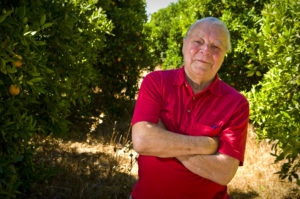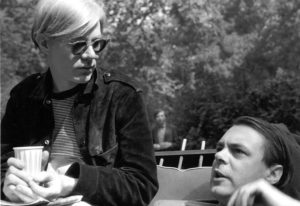PROFILES | By Bret Bradigan
Pioneering Journalist John Wilcock Dies
Pioneering alternative press journalist, one of the five founders of the Village Voice in 1955, died peacefully last night in Ojai. Here is a story written by Bret Bradigan for the Fall 2010 issue of Ojai Quarterly, where Wilcock occasionally contributed and consulted with over the years.

Pioneering Journalist John Wilcock Died in Ojai on Thursday. Father of the Underground Press, Avant-Garde Friend of Andy Warhol
The way John Wilcock tells it, Andy Warhol both craved and disdained fame. Witnessing that ambiguous relationship at a showing of one of Warhol’s films at a Manhattan theater, Wilcock remembers: “Andy’s limo pulled up for a midnight screening. The theater owner came running out to Warhol’s producing partner, Gerard Malanga, thinking he was Andy. Gerard was even signing autographs with Andy’s signature. Andy just stood in the background, smiling, playing along. He was impish, really enjoying himself. He had a unique capacity to turn everything to his advantage.”
Already a regular early-‘60s chronicler of Manhattan’s gallery openings and studio artists circuit, Wilcock was drawn, or pulled, into Warhol’s inner circle after Warhol moved into “The Factory,” his mid-town studio, where he began mass-producing art. “Not for nothing was it called The Factory,” said Velvet Underground musician, John Cale.
Wilcock’s introduction to Warhol was through avant-garde filmmaker, Jonas Mekas, who lured him to a screening of one of Warhol’s films. “I was impressed by the reaction — all the shouting and booing,” Wilcock said.
A British-born journalist, considered to be one of the fathers of the underground press, Wilcock was one of five original founders of the Village Voice in 1955, (which included Norman Mailer), where he wrote the first column, “The Village Square.” After a dispute in 1965, he left to start up the East Village Other while continuing to work as a travel editor at the New York Times.
In 1969, Wilcock co-founded Interview magazine with Warhol. Called the “Crystal Ball of Pop,” the magazine still flourishes, though it has become much more conventional since its origins as a quirky, freewheeling glimpse into the art world of Manhattan. Warhol, cavalier about paying, did eventually reimburse Wilcock for $6,000 in typesetting charges.
Though he now lives in a modest guest house in Meiners Oaks, nestled up against orange groves, he continues to crank out copy. “I still write 250,000 words a year,” he said.
As former editor of the Insight Guides, and of Arthur Frommer’s Budget Guides, Wilcock has traveled extensively, chronicling every place in great detail, together with lots of local color.
Born in Sheffield, England, famed for its steel industry, at age 83 Wilcock still actively seeks new experiences to write about for his blog at ojaiorange.com, or his hand-assembled publication, The Ojai Orange. His most recent trip was to the Columbia River Gorge to research the Lewis & Clark Expedition.
He also signed copies of his book, “The Autobiography and Sex Life of Andy Warhol” at Powell’s Books in downtown Portland, Oregon.
Originally written in 1972, it was recently republished by Trela Media for a series of talks in June and July sponsored by the New York Public Library and the Gagosian Gallery, covering Warhol and his legacy.
Neither an autobiography nor an account of the famously-reticent Warhol’s sex life, the book is instead a series of interviews with 20 key figures in Warhol’s life and the ‘60s Manhattan art scene, all with the purpose of trying to explain this odd and inscrutable artist.
The interviews are deep and revealing, as each of the people closest to Warhol struggles to find words to describe him. You get the impression that the more they think about it, the less they know for sure — that Warhol easily slips their grasp, even as he embeds himself deeper in their imaginations.

Andy Warhol and John Wilcock, close associates through the 1960s and 1970s.
Lou Reed, also of Velvet Underground fame and an early regular at The Factory, first met Warhol at a performance at the Bizarre Coffeehouse. Reed turned Wilcock’s simple question, “What was his reaction the first time he heard you?” back on the interviewer. “I don’t know. You were there, I think, when he attended the show — but you spent all your time behind a newspaper!”
Many of the myths that have risen around Warhol are deflated by his confidantes, though others are confirmed. Wilcock asked Met curator and long-time Warhol friend, Henry Geldzahler about Warhol’s reputation as a debauched libertine. “Andy doesn’t take that many drugs, and he doesn’t have a perverted sex life. You know, Andy goes to church almost every Sunday.”
A voracious consumer of information, Warhol found inspiration in an unlikely places. Fred Hughes, who managed The Factory for Warhol, said, “he thinks that department stores are like museums, so he likes to go to department stores.”
Leo Castelli, born in Trieste in the shambles of the Austro-Hungarian Empire, became, through his gallery and its promotion of Robert Rauschenberg and Jasper Johns, one of the founders of the Pop Art Movement, was actually a little late to recognize Warhol’s pre-eminence. But he made up for lost time, becoming a benefactor and friend.
“What do you think he’s most contributed to the world of art?” asks Wilcock. Castelli answers, “In a general way, I would say his freedom, his incredible sensitivity to what goes on in our present society, and his very superior, extremely valid aesthetic expressions of these freedoms. Usually, painters of such logical themes are bad painters. In his case, he has that achievement, which you also have in Rauschenberg, where the sociological approach does not disturb the aesthetic value.”
“You didn’t ask Andy any questions,” Wilcock said. “He just didn’t answer. He’d moan and stutter, and hem and haw.” This was during the period when Warhol was shifting his focus to movies. “I was just hanging around all the time, always scared they’d kick me out. But I just fitted in fantastically with Andy’s way of life. To be around him, you had to produce.”
Wilcock’s contribution was his gleanings from the street as a reporter and columnist, to feed Warhol’s powerful, insatiable curiosity. “He was like a human seismograph, always looking for fresh information. He just loved to hear about whatever was going on,” Wilcock said.
Though Wilcock has written more than 30 books, a 1991 profile in the British Independent noted, “He has an ability to make no money like others have an ability to make lots of it.”
He wears a maroon grandpa-style sweater, The Independent describing his dress sense as “famously horrible” and “arranged as if to promote the virtues of nudism.” (But if that’s the case, with the exception of bright yellow socks, I think he’s maybe slipping.) He serves up coffee on his patio, and after a conversation ranging from design flaws in his Sony Handycam to favorite living artists (he’s a fan of Christo, of yellow umbrella fame), he suggests a stroll over to the horses.
Art critic David Bourdon was asked by Wilcock if Warhol was in show business, and if so, did he enjoy it. “Oh, he likes it very much! He insists that he’s in show business and that he’s through with art; it’s very dull, and show business is much more glamorous and exciting. But he’ll tire of show business, too. Eventually, he’ll sweep the Academy Awards and then what? He’ll still be the same plain, love-starved little boy he always was.”
Warhol died in 1987 from complications following routine gallbladder surgery.
“One of the criticisms of Andy was that he was using people. But we used to say that ‘Andy exploited people to their own advantage.’”
Wilcock has a different take on Warhol’s famous observation that “in the future, everyone will get their 15 minutes of fame.” While Warhol, through creating art from everyday commodities and celebrities — think soup cans and Elvis — is often cited as a powerful influence on a modern culture that values notoriety over distinction and tabloid fame over worthy achievement. Wilcock believes his approach has been wildly, even willfully, misrepresented.
“I think he also meant that someday everybody will be an artist, that everyone, with no exceptions, has the potential to be genuinely creative.”
Wilcock’s “Autobiography and Sex Life of Andy Warhol” is available for $45 at trelamedia.com.

Leave A Comment